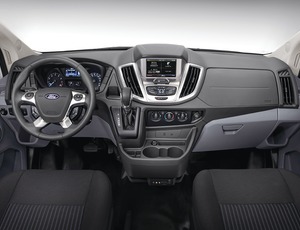

Like any tool, a commercial vehicle should be both functional and dependable, attributes often associated with Ford's best-selling E-Series work vans.
Formerly known as Econoline, Ford's E-Series has been the top U.S. contractor van for decades. However, with such competitors as Mercedes' Sprinter, Nissan's NV and the forthcoming Fiat-based Ram ProMaster van, the E-Series' glory days are fading. Early next year, it will be replaced by the 2014 Transit, a European model adapted for the U.S.
Ford sees great promise in its new van. "Commercial customers have held off purchases for the past five to six years," says Tim Stoehr, Ford product marketing manager. "Businesses are doing better, and now they're able to upgrade their fleets. They don't just want a new vehicle. They want a new vehicle that does a bigger and better job at a lower cost."
Like Mercedes' Sprinter but unlike the aging Chevrolet Express, the rear-drive Ford Transit van uses a unibody design with frame rails set behind the B-pillar. Much of the vehicle is constructed of boron steel, which improves torsional rigidity and durability.
Payload and towing capacities have not been announced yet, but gross-vehicle weights range from 8,600 lb for the Transit 150 to 10,300 lb for the heavy-duty, dual-rear-wheel 350HD, with models in between. The list of possible configurations is long. Buyers can choose two wheelbases, three roof heights, two body lengths, and two trim levels as well as chassis-cab and cab-cutaway variants.
The smallest of the bunch, the Transit MWB (medium wheelbase), with a low roof provides up to 248.3 cu ft of cargo space and matches the Nissan NV's interior height of 55.8 in. By contrast, the Transit LWB EL (long wheelbase, extended length) with a high roof delivers 496 cu ft of usable space, and its 81.5-in. interior height beats the tallest NV by more than four inches.
When less space is required, buyers may want to consider the 2014 Ford Transit Connect. This front-drive utility vehicle offers a short or long wheelbase, up to 132.3 cu ft of cargo space and two trimmings. Towing capacity tops out at 2,000 lb, while payload peaks at 1,600 lb.
Power and Efficiency
Compared to the E-Series, Transit's fuel economy is expected to improve by 25%. The base engine is a 3.7-liter V-6 available with a gaseous-fuel prep kit. Specifications and fuel-economy figures have not been announced, but using the F-150 pickup as a reference suggests horsepower may be in the 300 range and torque roughly 278 lb-ft. A six-speed automatic transmission is standard on all models.
Next up is a turbocharged 3.5-liter EcoBoost V-6 that, in F-150 guise, generates 365 hp and 420 lb-ft of torque. Ford claims it will be the most powerful gasoline engine in any commercial van.
Rounding out the lineup, a 3.2-liter Power Stroke, an inline-five turbodiesel, is B20-biodiesel-capable and expected to put out 197 hp and 347 lb-ft of torque.
For 2014, Ford will usher in a new era of commercial-van technology. "Commercial customers want technology … because it's going to make them more money," Stoehr states. Transit will be available with Crew Chief, a fleet-monitoring tool, and with SYNC, MyFord Touch and Sirius Travel Link, which can display local fuel prices.
Another technology, MyKey, can be programmed so that these tools won't work if the seat belt isn't buckled, Stoehr says, adding, "What's that worth in insurance premiums if 100% of your drivers are buckling up every time they drive?"


Post a comment to this article
Report Abusive Comment